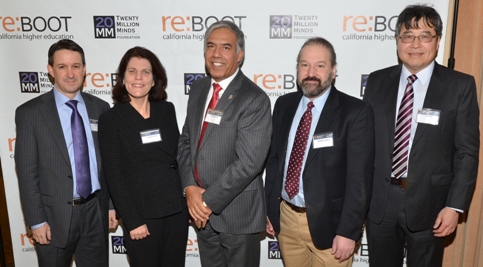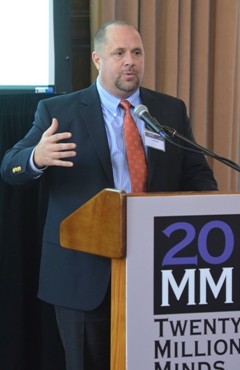California Switches Driver on Road to Future of Higher Education
Published by: WCET | 1/15/2013
Tags: Cost Of Instruction, Innovation, Legislation, Online Learning, Technology, Tuition And Fees
Published by: WCET | 1/15/2013
Tags: Cost Of Instruction, Innovation, Legislation, Online Learning, Technology, Tuition And Fees
In dealing with tight budgets, limited access to courses, growing costs to students, and concerns about educational quality, we’re noticing that governors and legislators in states and provinces are asking tough questions. Many see technology as part of the answer and they are engaging their higher education leaders in designing ways to better serve their citizens’ needs. Florida and California recently held statewide meetings addressing these issues. We’ll soon have a blog post on the Florida meeting. Covering the discussion in California in today’s guest blog, we welcome Phil Hill, co-founder of MindWires Consulting, as a guest blogger. Phil is a consultant and industry analyst covering the educational technology market primarily for higher education. Catch Phil on twitter @PhilonEdTech.
In past years the primary role of state government was to take the lead on funding while working with statewide systems on enrollment policies to serve workforce and general educational needs. Last week in California we witnessed the state government, both from the governor’s office and the legislature, become the driving force of change for determining the role of educational technology and online education to transform the public systems. State officials are no longer content with encouraging and hoping that postsecondary institutions will develop a strategy for systemic change on their own.
Three interdependent events are emerging that clarify this trend.
The common theme was captured by 20 Million Minds leading up to their conference:
“As a first approximation, the state should focus its attention on arresting the growth of the cost of education while maintaining or even increasing access and quality, not by simply urging educators to “do more with less,” but by enlisting their active participation in and contribution to innovative approaches. [snip]
[The state should] take a leadership role and accelerate our efforts to take advantage of the cost-saving potential inherent in online education.”
New Role of State Government

What is new in this discussion is the role that the governor’s office and legislature are taking in forcing these issues.
Governor Jerry Brown kick-started the discussion in November in his meetings with the University of California board of regents and California State University board of trustees as described in the LA Times article.
“In order to meet the needs going forward without constant large tuition increases, there will have to be different ways in which people learn and people teach,” Brown said [snip]
Brown said he wanted those talks to be “not in the gilded tones of academia but in the harsh reality of the marketplace and technologies.”
These ideas are central themes of the governor’s proposed budget, as described in this story from CBS Los Angeles.
“Brown proposed a plan to steadily increase funding for the three systems over the next four years, but only if they freeze fees at current levels, noting that UC and CSU tuition has nearly doubled over the past five years. [snip]
“The people in the university are going to have to find a way to do the same thing with fewer growing resources than they’re used to,” Brown told reporters Thursday. “Can we turn down this relentless increase in spending that is so much higher than the cost of living?”
Brown wants colleges and universities to expand the number of online courses they offer to reduce costs and allow more students to get the classes they need to graduate.
His budget plan calls for UC and CSU to each spend $10 million to develop digital versions of high-demand courses — and $17 million for the community college system to develop a “virtual campus” of 250 new online courses.”
In his welcoming remarks to the Re:Booting California Higher Education conference, Senate President Pro Tem Darrell Steinberg called for an expanded view of public education to move beyond “teaching to the tests”.
“The question, in my view, isn’t how we replace UCLA or other fine institutions or how we supplant what is going on. The question is how we broaden the definition of public education, with all the academic rigor we currently have, but to bring in more career and workplace application. Take more of our educational experience outside of the classroom, and then use the web and use the technology that we have supplementing real-life experiences for students.”
Jeff Selingo (who gave the keynote at the conference) offered his perspective on the lieutenant governor’s involvement in the conference.
“You won’t often find the lieutenant governor of a state at a higher-ed conference, but there was Gavin Newsom of California sitting next to me on Tuesday at UCLA for a discussion about how online learning might help the state’s cash-starved public colleges increase access. He wasn’t there just for a photo-op. He stayed basically the entire day and took notes. A lot of them, and on the subject (I looked). He rarely glanced down at his phone.”
Of the three public systems, only the Community College system has aggressively expanded online offerings as a strategy for managing costs. Currently 17% of CA community college courses are offered online.
The next major events in this saga will be the follow-up meeting at the UC Board of Regents (Jan 15-17) and the CSU Board of Trustees (Jan 22-23). These meetings will be crucial in seeing how the systems respond to the calls from Brown, Newsom, and Steinberg. As pointed out in the Sacramento Bee, the “university system is administered independently by the regents and subject to only limited legislative oversight” – there will be a give-and-take of hard and soft influence required for state officials to prompt significant changes in system strategy.
But for now, the simple fact that the state government leaders have taken over the driver’s seat in the discussion about the role of online education, with system leaders being pulled along, is a significant change in California higher education.

7 replies on “California Switches Driver on Road to Future of Higher Education”
[…] Read the whole article here. […]
There are two parts to an edu inst. there is instruction on which the event focused and the scholarly. Those who pay for the edu side are concerned about what and how they get the “what” . Today the “what” is basically P-16 . The faculties in the HEI’s have to understand that the difference between 9-12 and 13-16 faculty and the “what” being provided is becoming seamless. There is cognitive dissonance here as much of the scholarly privilege of the past has been subsidized by edu and that is unraveling in many institutions. Academics raise arguments here in much the same way that brakemen on trains and flight engineers in planes made. But, the momentum is there. The money is a symptom and to see it as the issue is the same as with medicine where it diverts from dealing with the system problem.
[…] **See Phil Hill,Guest Blogger’s post on WCET entitled California Switches Driver on Road to Future of Higher Education […]
[…] **See Phil Hill,Guest Blogger’s post on WCET entitled California Switches Driver on Road to Future of Higher Education […]
A follow-up story on Governor Brown promising more money, but asking the institutions to keep tuition flat and improve their efficiency in producing graduates: http://chronicle.com/article/California-Governors-Budget/136615/?cid=at&utm_source=at&utm_medium=en
Russ
[…] « California Switches Driver on Road to Future of Higher Education […]
[…] of MindWires Consulting and co-publisher of the e-Literate blog) as a guest blogger to update a January 2013 post for WCET in which he outlined how the California government was trying to drive higher ed. Given […]